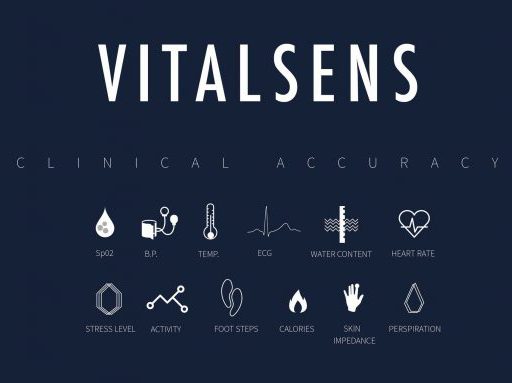
VitalSens
Vitals Monitoring
Next-gen technology platform for wireless monitoring of vital signs
Wearable health monitoring
HTIC is actively conducting R&D in the area of wearable & wireless vital signs monitoring and connectivity enabled mHealth solutions that are equipped to leverage the power of IoT solutions. Devices to be worn on various parts of the body such as chest, limbs, ear etc are being developed. Networked operation of multiple health monitors to develop a comprehensive health evaluating system is also being investigated.
HTIC is exploring novel sensing modalities, incorporating sensor fusion and intelligent algorithms to enable clinically accurate and reliable measurements of vital parameters, in a minimally obtrusive manner.
Extensive clinical validation of the different prototype devices being developed as part of ongoing research is being planned, in partnership with the various clinical collaborating partners in HTIC’s ecosystem.
Clinical applications
In addition to usage scenarios such as home health and emergency care, multiple clinical applications have been conceptualized, based on parameters such as reflectance SpO2, ECG (single lead and 12 lead) for cardiac monitoring and arrhythmia detection, HRV monitoring using optical sensors, EDA and Stress monitoring, Core body temperature.
Other important and novel applications being researched are Cuff less BP measurement, Fall detection and Gait analysis.
Vitalsens platform
HTIC is developing a modular, next gen technology platform for wireless health monitoring, focused on reliable capture of vital signs from various parts of the human body with clinical grade accuracy.
HTIC is engaged in a long-term international collaborative project with a Finnish consortium of academic institutions (Tampere University of Technology, Oulu University, Metropolia University of Applied Science) and industry (GE Healthcare, Medieta, Haltian, Polar Electro, Omegawave, IDSens) for the development of a platform technology for affordable continuous health monitoring. The proposal is based on the unaddressed gap and need for an effective sensing and processing technology that can reliably monitor vitals in a minimally obtrusive manner, with wireless transmission capability, which can be adapted to different situations from a hospital setting to home health and ambulatory monitoring.
This project aims at creating a reconfigurable solution platform that consists of an application-dependent selection of sensors, a secure data channel to a back-end cloud service, and a user interface that can be adjusted for the needs of the respective application. Cost-effective and ergonomic sensors for physiological monitoring will be developed using printed electronics technology.
Wrist-wearable health monitor
HTIC has developed a wrist wearable vitals monitor, with integrated data recording and wireless transmission capabilities, for a med-tech start-up. The device operates in conjunction with a smart phone/tablet device and is supported by a cloud service that would offer advanced data visualization and analysis capabilities, and value added services to the end customer. This wrist worn device monitors heart rate, body temperature, blood oxygen saturation levels (SpO2) and body activity. Wireless connectivity using BLE technology transfers the data collected by the device to the smart phone/tablet, which is then synced with the cloud.
Unlike currently available fitness monitors, this device is targeted at chronic disease management and would be prescribed by a clinician. An extensive clinical care delivery ecosystem, including clinicians, on-site care providers and hospital support (already developed by the start-up company with established clinical partner network) enables timely intervention on the events detected by the wrist worn device, thereby enabling the device to ensure timely care delivery, in a model that is also economically viable and sustainable.
ECG Patch
HTIC had developed a single lead chest ECG patch with wireless connectivity for collecting heart rate, RR interval and respiration data. We are currently working on adding intelligence to the device which will enable the device to detect arrhythmias which are associated with variable RR intervals. Worn on a patient’s chest using standard and replaceable ECG electrodes, it also incorporates an ECG visualisation function for set up and verification. Benefits of the wireless, wearable patch are mentioned below:
Greater freedom of movement for patients
Reduced false alarms from cable detachment or interference
Reduced work and enhanced efficiency for nursing staff
Clinical study of pilot prototypes
Clinical data collection using a set of pilot prototypes is currently in progress. Such an experimental exercise is of great value to understand, characterize and analyze signals recorded by the device under various conditions (which is influenced by the subject’s activities) which is the key to develop intelligent and reliable algorithms for making high quality wearable devices of clinical grade. The annotated database accrued from such an experiment would be of significant value in developing and fine tuning algorithms.
